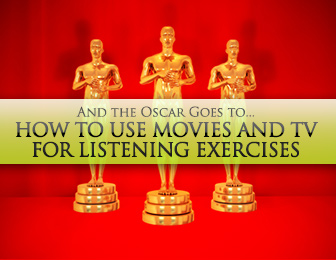The Real World: Authentic Listening Opportunities for the ESL learner


Do some detective work and find out what your students would really enjoy, and you might just find yourself in the position of a movie star, accepting all kinds of accolades from elated students!

If your students happen to be movie or TV fanatics, they might be very interested in doing some activities surrounding the Oscars, the Emmys, or any of the other numerous awards shows out there nowadays. You can organize lessons on current shows or utilize the internet to locate archives of particular years, stars, or movies. You may also weave in lessons that include the history of particular films, movie clips of favorite actors, or famous scenes or lines. You could also include modeling your own awards show after a particular one you watch. Utilize the awards show by looking for specific language points. Superlatives is an obvious one, as is the different presentations of thank you. These are also wonderful examples of scripted humor, emcee monologues, and formal speeches. Excite students by allowing them to plan, for example, an Oscar viewing party in which you choose the three awards the class would like to see and watch them being presented. Students can answer set comprehension questions, describe their favorite moments or lines, or even do imitations of some of the acceptance speeches. These listening exercises coupled with lead-in reading and speaking activities provide a whole language experience. There are a lot of ways to engage students by bringing in awards shows. Gear up in advance, focus on delivery and vocabulary, and of course discuss what people were wearing!
Do you ever discuss popular TV shows with your class? Are they following a particular show in their language that could be a candidate for them to view in English? If you answered yes, it's a pretty safe bet that your students would be excited and motivated to do some studying by watching TV. It's easy to use the internet to find clips of popular TV shows, movie trailers, or TV show previews. You could try searching YouTube or Hulu to find what you need. When considering showing any amount of TV to your class, it is much easier to devise listening exercises based on short clips or previews than it is on whole episodes. TV shows offer real dialogue at an incredibly fast rate of speech. Don't overwhelm students by having them watch too long of a clip. You want to be sure to go over necessary new vocabulary beforehand, and include either some cloze listening exercises, comprehension questions, or an introduction to the theme of what they will view.
One very popular TV show that you could utilize is ‘Friends’. Students in many countries are familiar with it, and if you take it in small enough increments you could do a lot with it. Sitcoms, in particular, offer a lot to the ESL Learner. Often, these shows are familiar, accessible, and provide life lessons as well as interesting dialogue and characters. Students can often relate to subject matter that is approached in sitcoms and the humor is pretty family-friendly for the most part. Idiomatic speech runs rampant in these shows, so if you have advanced-level learners, you could get their feet wet by allowing them to watch an entire 20 minute episode.
One other interesting option to consider is locating some bloopers from familiar TV shows. This is an effective way for students to see a variety of mistakes being made and to attempt to comprehend what went wrong. TV can be a source of education and learning if you use it in the right way. Bring some TV viewing into your classroom, and students will have a lot to share after their listening experience.
Disney movies can bring magic into your classroom in that you will have students undivided attention in a way like only Disney can do. Students big and small are fans of Disney's animated features as well as some of the other family-friendly options. Animated films are perfect for listening exercises in and out of the classroom. A true benefit of introducing Disney to students is that you can make good use of the movie's subtitles. For example, you could watch a few scenes only in English, stop the video and then jump into discussion or comprehension exercises. If students ran into trouble understanding a chunk of the scene or if they have multiple questions, one option is to go back and watch the scene with subtitles of their local language. This works well for uni-cultural classrooms, but if you have a multi-cultural situation you may just want to watch the movie in English with the English subtitles on. Utilizing the English subtitles can open up a new world for students who can then trust their listening because it is combined with reading. Disney movies are also wonderful to focus on idiomatic speech, life lessons, and also provide great vocabulary skill building.
You can approach these listening exercises with creativity or you can keep it to simple comprehension and discussion. However you go about it, students will enjoy listening to and watching TV and movies in English.